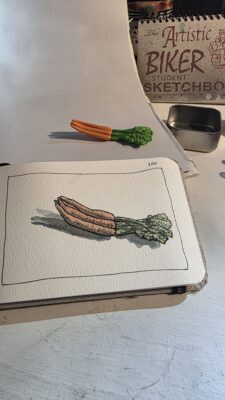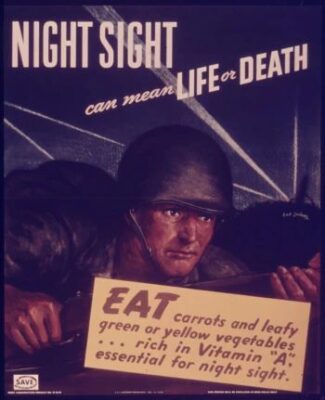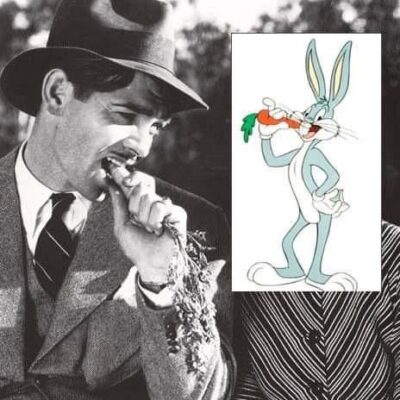
The 100th daily sketch was a bunch of carrots. Because nothing says ‘momentous occasion’ like biting into wartime propaganda and cartoon cool.
Sketch and Coffee Live at 5:30am Texas Time
I marked the 100th consecutive stream by sketching a toy carrot bunch. At first glance, it felt underwhelming, but once the sketch got going, the conversation got juicy. The shape was fast to block in because carrots are really just a bunch of triangles. I’m convinced Girl2 sets the easy ones aside for me to do on Tuesdays so I’m not late to my weekly meeting at the day job. The fast composition let us dive deep into the tangled roots of carrot history.
Carrots were first gathered around 5,000 years ago, but weren’t widely cultivated until around 1,000 BCE. Those early carrots weren’t orange. They were bitter, gnarly roots in purple, yellow, and white, depending on their region such as Afghanistan, Persia, or Europe. Early on, they were mostly cultivated for animal food and for the seeds to be used in medicines. Red carrots came out of India, and I’m still hoping to taste one someday. They’re supposed to be really sweet. It wasn’t until the 16th or 17th century that the Dutch bred the orange carrot, likely in tribute to the House of Orange. They also bred the smooth, tapered shape for easier harvesting and prettier produce. Ironically, we now throw away the gnarled ones. That’s where “baby carrots” enter the picture. Cutting down the gnarly ones makes them more marketable. That little innovation turned cosmetic culls into a billion-dollar snack industry. Today, 70% of all fresh carrots consumed are baby carrots. The U.S. alone eats 2.8 billion pounds of carrots a year.

Then we got to the good part: WWII. When the British started intercepting enemy planes with radar, they needed a cover story. So they credited their pilots’ “amazing night vision” to eating carrots. Posters spread the lie. Farmers ran with it. And right on cue, Bugs Bunny started munching carrots on screen, mimicking Clark Gable in It Happened One Night. It was perfect timing. The myth stuck, and carrot sales exploded. Mel Blanc, the voice of Bugs, was allergic to carrots, but he still bit into real ones during recording because no sound effect could replicate that crunch. He’d chomp, speak, and spit into a trash can.

So here’s to carrots. To cartoon timing, sneaky science, and weird little roots that somehow made it to the top of the veggie world. Thanks for 100 amazing mornings. Let’s keep going.
Leave a Reply